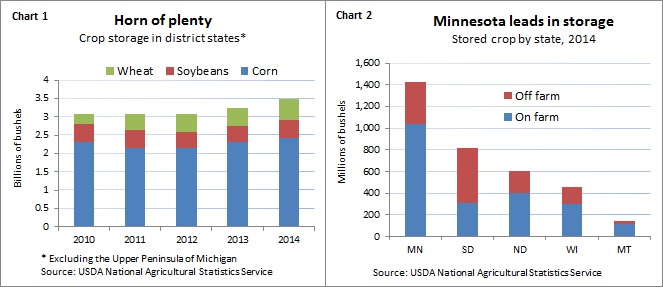A bumper 2014 harvest combined with low prices has piled up crops at grain elevators and on farms in the district.
Last fall, growers in five district states (excluding Michigan’s Upper Peninsula) harvested about 4.4 billion bushels of corn, soybeans and wheat, according to government statistics. That was 3 percent more than the previous year and the largest harvest of those major district crops in the last five years. A decline in crop prices since 2013 induced many farmers to store their crops over the winter rather than ship them to market via rail or river barge.
The result was a cornucopia of stored crops; the U.S. Department of Agriculture estimated that December stocks of corn, soybeans and wheat increased 7 percent over 2013, pushing up crop storage (see Chart 1). Almost 3.5 billion bushels of crops—equal to about 80 percent of the 2014 harvest—was held at grain elevators, other commercial storage facilities or on the farm. (That amount included unprocessed crops left over from the 2013 harvest.)

About 40 percent of crops were stored in Minnesota (see Chart 2), the top producer among district states of corn, the region’s biggest cash crop. And in every district state, a large share of crops was stored on farms in silos or bins. Over the past 15 years, farmers have invested substantially in on-farm storage to avoid paying for off-farm storage.
“Given the low prices, every square inch of on-farm storage was utilized this year,”’ said Bob Zelenka, executive director of the Minnesota Grain and Feed Association, which represents rural elevators and feed mills.
Regardless of crop prices, farmers are expected to ship large quantities of stored crops to market by the summer. This has raised concerns about renewed congestion on freight railroads, which transport the bulk of agricultural commodities in the district.
Railroad capacity in the district last year was strained by severe weather and rising freight volumes, including increased shipments of crude oil. For much more on railroad capacity in the district, see the upcoming April issue of the fedgazette.





